After a brief ride on the e Access, we attempt to answer whether Suzuki’s slogan holds true.
The Honda Activa is the single largest selling scooter in India and has unmatched brand recognition in our market. Yet, when the Activa e: debuted, because of some crucial misses, it didn’t strike the right chord. The reason I bring this up is that we are about to discuss the Suzuki e-Access, which is another Japanese electric scooter bearing a badge that’s well established in India. So, has Suzuki succeeded where its Japanese compatriot hasn’t?
Suzuki e Access design and colours
e Access has an unusual design and comes in three colours
One glance at the e-Access will tell you that Suzuki has thrown the family scooter design rulebook out the window. Depending on who you are, that will be a good or bad thing. I think the e-Access looks a lot better in the flesh than in pictures, although that double ‘duck bill’ front end will be an acquired taste. Love it or hate it, this unconventional design will help it stand out on the road from the sea of family scooters. The e-Access can be had in three colours – black/red, green/silver and white/silver.
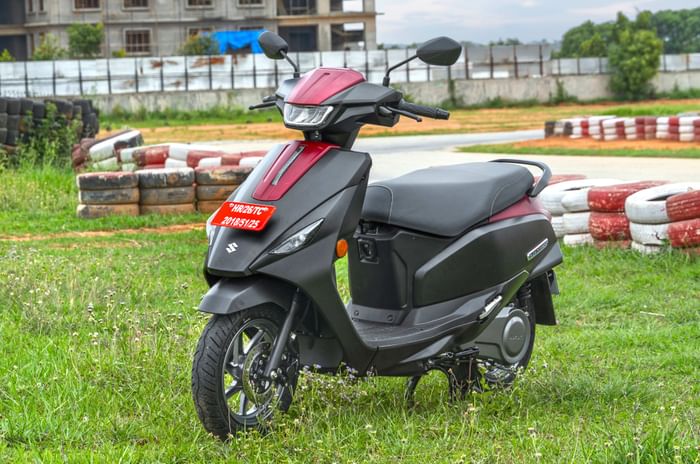
The e-Access has a rather unconventional design.
Suzuki e Access battery and range, charging time
e Access uses an LFP battery with 95km claimed range
Another area where Suzuki has gone down a different route than every other well-known electric scooter on sale is the e-Access’ battery chemistry. It uses an LFP (Lithium Ferrous Phosphate) battery in a market dominated by NCM (Nickel Cobalt Manganese) batteries. The two sides of that coin are that while LFP batteries are safer and longer lasting, they cannot match a similarly sized NCM battery in terms of energy density.

The fast charger can top up the e-Access’ battery in just over 2 hours.
Therefore, it’s not surprising that Suzuki claims a 95km certified range from the e-Access’ 3kWh battery, roughly 20 percent less than the equivalent e scooter using an NCM battery. Suzuki will supply a 600-watt portable charger, which takes 6 hours 20 minutes to top up said battery from flat to full. The company also says that it is going to set up fast charging stations at all its outlets this year itself. Using that charger will fully charge the battery in just 2 hours 12 minutes.
Suzuki e Access features
It is a decently feature-rich offering
Coming to the features front, while the e-Access has the usual gaffe of smart features (accessible via pairing your smartphone to the 4.2-inch TFT dash), three riding modes (Eco, Ride A and Ride B), a USB charging port and the like, I’d like to give a special mention to a very intuitive feature. The scooter’s seat stays open in the position you leave it unassisted (a la Bajaj Chetak), which is a very handy thing if you’ve got both your hands full.

The seat stays open unassisted.
The trouble is that the under-seat storage area on the e-Access can hold just 17 litres – about half the size of most other rivals. In fact, even the latest-gen petrol Access has a bigger boot than the e-Access. Missed opportunity, Suzuki.
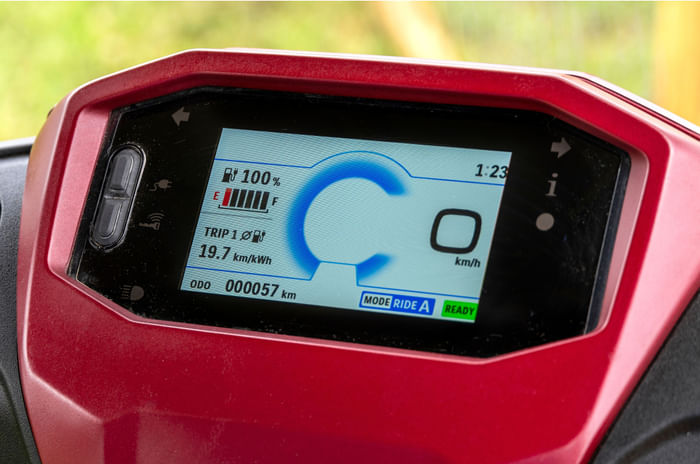
The 4.2-inch colour TFT display is bright and well-laid out, but the bezels are rather large.
Suzuki e Access ride and handling
It is a surefooted and predictable handler
But where the company has played to its strengths are in the way the e-Access behaves once you start riding. We were given just 45 minutes on a go kart track, so our learnings aren’t the most comprehensive. Even so, this thing showed real promise.
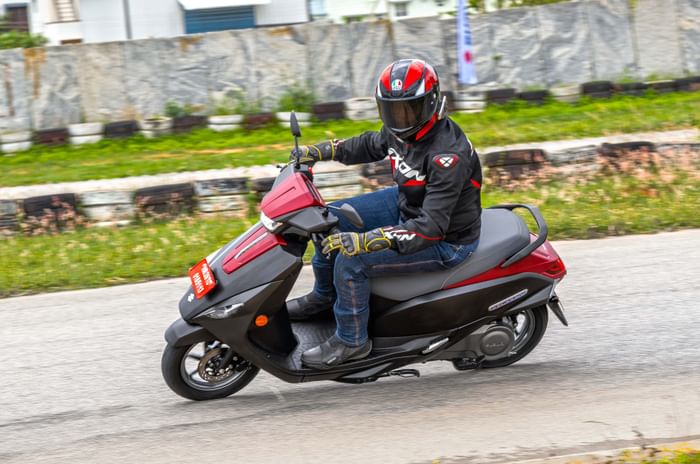
It is a sure-footed and predictable handler but isn’t energetic.
While it isn’t as energetic a handler as an Ather 450, our experience so far suggests that the e-Access is flickable enough that slicing your way through dense city traffic won’t be an issue. Performance is also measured and calm, with a gentle and progressive build of power that will be welcoming for both newer riders and the average scooter user. Be warned though, if you’re expecting a zippy EV experience, you may want to look elsewhere.

17-litre boot is much smaller than other EVs in this class.
Suzuki e Access ride modes, regenrative braking
Ride modes are well thought-out but switching between them isn’t straightforward
That being said, Suzuki has thought out the ride modes very well and you can easily bop around town even in Eco, which limits you to 55kph. However, Suzuki has needlessly complicated switching between the three modes. You can switch from Eco to either Ride A or Ride B on the move, but you can’t switch between Ride A and Ride B while riding. Before you set off, you must program what Ride mode you’d like to switch to from Eco, and to change that, you’ll need to stop again.
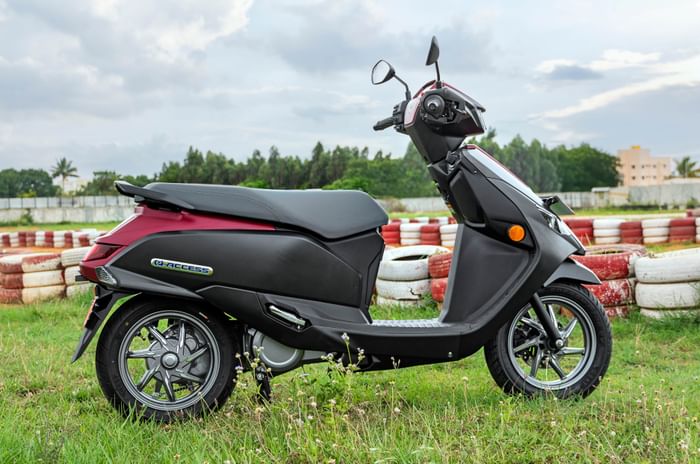
Toggling between the riding modes should’ve been a more straightforward experience.
Suzuki says this was done so that riders don’t get caught off-guard with the differing regenerative braking settings between Ride A and Ride B. To be honest, we think the difference isn’t that big and this seems like an unnecessary complication on an otherwise straightforward scooter.
Seating comfort seems to be bang on with a very neutral rider’s triangle complemented by a spacious, well-padded seat. We only went over a few plastic composite speed breakers placed on the track in our stint with it, so it’s hard to pass a definitive verdict on suspension comfort. But the e-Access felt like it was ironing out a lot of the jolt.
Suzuki e Access price expectation and verdict
It’s a well-engineered and thoughtful scooter, although pricing is a question mark
So far, it’s the typical Suzuki story. It’s a practical, well thought-out and high-quality machine, which is what most potential customers are looking for. So that’s half the battle won. The problem is, since Suzuki hasn’t revealed the price (or so much as given a hint about it), summing this rather likable e-scooter up is something we’ll reserve for another day.
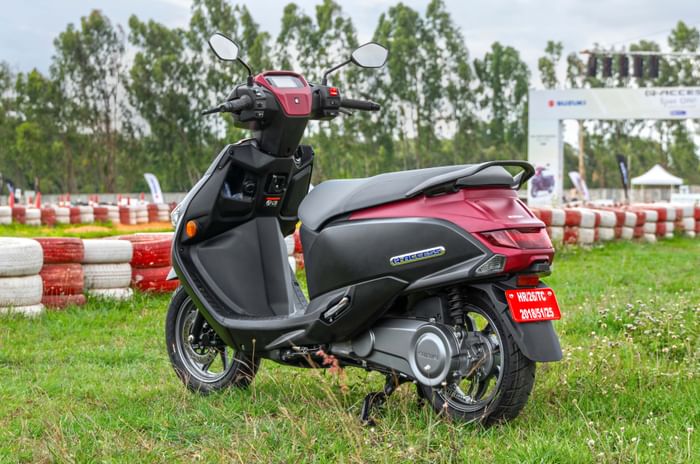
The e-Access is a sorted package, but its pricing will determine its success.
However, if Suzuki does manage to price it sensibly (around the Rs 1.20 lakh ballpark, ex-showroom), then I think the e-Access will find takers as it is a no-nonsense and practical offering that comes from a steadfast Japanese brand that’s known for its reliability the world over.
Also See: Suzuki e Access video review

